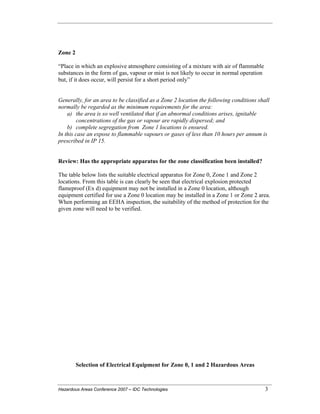The Definitive Guide for Roar Solutions
The Definitive Guide for Roar Solutions
Blog Article
The Single Strategy To Use For Roar Solutions
Table of ContentsRoar Solutions - An OverviewThe 9-Second Trick For Roar SolutionsLittle Known Facts About Roar Solutions.
In such an atmosphere a fire or surge is possible when three fundamental conditions are fulfilled. This is usually described as the "hazardous area" or "combustion" triangle. In order to secure installations from a potential surge a method of evaluating and classifying a potentially harmful area is called for. The function of this is to make sure the right choice and installment of devices to ultimately protect against an explosion and to ensure safety of life.
(https://leetcode.com/u/roarsolutions/)
No devices ought to be set up where the surface temperature of the tools is better than the ignition temperature of the offered hazard. Below are some typical dirt hazardous and their minimal ignition temperature. Coal Dirt 380C 225C Polythene 420C (melts) Methyl Cellulose 420C 320C Starch 460C 435C Flour 490C 340C Sugar 490C 460C Grain Dust 510C 300C Phenolic Resin 530C > 450C Aluminium 590C > 450C PVC 700C > 450C Residue 810C 570C The probability of the threat existing in a focus high enough to create an ignition will vary from location to area.
Hazardous area electric tools maybe developed for use in greater ambient temperatures. Field Repair Service By Authorised Worker: Complex screening might not be needed however certain procedures might need to be followed in order for the equipment to keep its 3rd celebration rating. Each piece of tools with a hazardous score need to be evaluated individually.
Indicators on Roar Solutions You Should Know
The devices register is an extensive data source of tools documents that includes a minimum set of fields to recognize each product's place, technological criteria, Ex lover classification, age, and environmental data. The ratio of Detailed to Close evaluations will be determined by the Devices Threat, which is assessed based on ignition threat (the likelihood of a source of ignition versus the probability of a flammable atmosphere )and the harmful area classification
( Zone 0Area 1, or 2). Implementing a durable Risk-Based Evaluation( RBI )approach is critical for guaranteeing conformity and safety and security in taking care of Electric Tools in Hazardous Locations( EEHA).
A Biased View of Roar Solutions

In terms of explosive risk, a harmful area is a setting in which an eruptive atmosphere exists (or may be anticipated to be present) in amounts that require unique preventative measures for the construction, setup and use tools. hazardous area electrical course. In this write-up we explore the challenges dealt with in the office, the risk control actions, and the needed expertises to work securely
These substances can, in particular problems, form eruptive environments and these can have major and unfortunate repercussions. Many of us are acquainted with the fire triangular remove any type of one of the 3 aspects and the fire can not occur, however what does this mean in the context of unsafe locations?
In many circumstances, we can do little regarding the levels of oxygen airborne, but we can have significant impact on resources of ignition, for instance electric equipment. Dangerous areas are documented on the harmful area category drawing and are identified on-site by the triangular "EX-SPOUSE" indication. Below, amongst various other key details, areas are split right into three types depending on the hazard, the probability and duration that an eruptive atmosphere will exist; Area 0 or 20 is deemed one of the most harmful and Area 2 or 22 is regarded the least.
Report this page